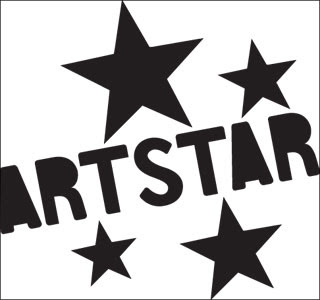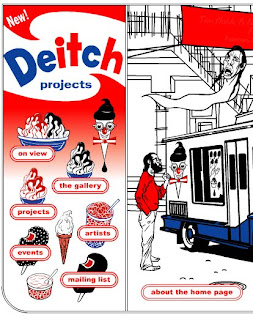
“Bored, Naked, Desperate What happens when artists go on reality TV.” By Dushko Petrovich (from Slate dot com)
“I’m bored with that line. I never use it anymore. My new line is ‘In 15 minutes everybody will be famous.’ ” –Andy Warhol
The new show ARTSTAR (Gallery HD, Thursdays at 9 p.m. ET) enticingly promises to marry the sensibility of Warhol’s Factory to reality TV, as contestants work toward a coveted spot at one of New York’s leading galleries. The first shock is that nobody did this sooner—history will note that it took the New York gallery scene 14 years to hook up with TV’s avant-garde, The Real World, which debuted on MTV in 1992. If Andy Warhol turned fame into an art form, and reality TV has turned fame into a game, what happens when the two collide?
ARTSTAR starts off looking like a line at a soup kitchen. Of the hundreds of contestants who showed up in bad weather to audition, many mocked their own desperation. That saves us the trouble, but gallery owner Jeffrey Deitch, the show’s impresario, might have overstated the quality of the contestants when he observed that “In the 1970s … no self-respecting artist would have stood in line to try to get on a television show.” After watching people cry, bare cleavage, scribble wildly, and even use PowerPoint to vie for a slot on ARTSTAR, it seemed that self-respecting artists might still be declining Deitch’s invitation.
The show isn’t helped by its poor editorial decisions. Once Deitch picked his eight contestants, he decided to forgo the handy elimination structure shared by almost all reality shows. A less competitive framework must have sounded more pleasingly documentary, but the plot suffers right along with the characters. It’s hard to tell, for example, if all eight of the artists have become Artstars simply by being chosen or if they are somehow competing to become an Artstar. The would-be Artstars are definitely grateful for the opportunity, but they keep saying, in the private asides, that they don’t exactly know what they’re doing on the show.
Neither do we. After two hour-long episodes of ARTSTAR, not a single art object has been made. The Artstars mostly spend their on-air time around a boardroom table worrying about their marching orders, hearing about more auditions (naked ones!), and getting mini-lectures on recent art history. They do literally get marching orders, as Deitch decides the contestants should collaborate on an “art parade” rather than have a standard gallery show. But what’s a wood sculptor to do? And the rest of the cast, despite some less-than-conventional art practices, clearly had their hearts set on a conventional gallery show. But not so fast, Artstars. Like Donald Trump, Deitch is the boss.
But unlike his savvy precursor, Deitch is mostly charmless. A serious fault, as he’s the real focus of the show. He even does the voice-over narration. The second episode starts with a mini-documentary about Deitch’s gallery-world ascent, with superstar artists and dealers such as Jeff Koons and Mary Boone providing testimonials, and Deitch himself explaining his business ideas. Product placement abounds. The Deitch Projects logo, which is a reappropriation of the Brillo Box Andy Warhol famously appropriated back in 1964, pops up often. Instead of Brillo, Deitch’s box says … “Deitch.” Occasionally, instead of Deitch, it says “HYPE.” At times, ARTSTAR feels like an upscale infomercial.
 The real products, of course, are the Artstars themselves. They are diverse and competent people who seem hardworking and nice, so it’s hard to say what’s wrong with them, except that they are dull. Much of their speech sounds like pre-rehearsed art-school talk—discussing “issues of gender and representation”—and they come across as docile in their opportunism. They frankly discuss their practical reasons for being on the show, and you feel for them. The problem is that none of them want to make good television. They want “budgets.” They want to be able to support themselves only with art. They want a good gallery to promote them. To get all this, they keep saying they need “access.” But what will they do to get it? And will it be entertaining?
The real products, of course, are the Artstars themselves. They are diverse and competent people who seem hardworking and nice, so it’s hard to say what’s wrong with them, except that they are dull. Much of their speech sounds like pre-rehearsed art-school talk—discussing “issues of gender and representation”—and they come across as docile in their opportunism. They frankly discuss their practical reasons for being on the show, and you feel for them. The problem is that none of them want to make good television. They want “budgets.” They want to be able to support themselves only with art. They want a good gallery to promote them. To get all this, they keep saying they need “access.” But what will they do to get it? And will it be entertaining?
At the end of the third episode, the contestants are invited to be a part of a spectacle that involves putting naked supermodels in public spaces. The Artstars can audition (that is, undress) to be in the performance. Two of them, a cross-dresser and a woman who glues feathers on her face, are excited by the opportunity. The cross-dresser, still clothed, even fools the judge, who has to rescind the invitation upon discovering that the cross-dresser “can tuck really well.” The rest of the Artstars stand by, either uninvited or unimpressed, and a few wonder aloud about the value of the naked supermodel project. None of them wonder about the value of the show they’re on, but stay tuned: Like the home audience, the Artstars are getting restless.
Just in time, Episode 3 features a party. We glimpse some bra-less schmoozing, some vodka-guzzling, and a lot of nicely dressed people standing around. “Not a lot of art is going to get made tonight,” concedes Deitch, but of course that’s normal for a party. What’s weird, and sneaks by without comment, is how little artwork matters to the show. Future episodes promise more art and more drama, but, fancy party notwithstanding, the show is off to a complacent start.
ARTSTAR’s appearance represents a funny stage in the so-called dematerialization of the art object, which was heralded as progress by such artists as Joseph Kosuth and Yoko Ono, who hoped to end the commodification of art by eliminating the object. Radical artists once dreamed of a purified realm of concepts, but thanks in part to business-savvy showmen like Jeffrey Deitch, the dematerialized scene that ensued has turned into a kind of circus. Watching ARTSTAR, you get the funny feeling that what triumphantly replaced the commodification of objects ended up as the commodification of people.
But the problem with ARTSTAR isn’t the bad reality so much as the bad reality TV. So far, there is none of the trashy drama, smart editing, and pure sadism that gives the genre its nerve. Instead, ARTSTAR gives us all the awkward self-promotion and conflicted monologues of the art world, without the art. The poor Artstars, meanwhile, are caught in an embarrassing trap: They think that notoriety is some kind of precondition for art making, an activity they postpone as they are finding out what they should do to get noticed. It’s painful to watch them get it so backward, but not to worry: In 15 minutes, they’ll get their privacy back.
To read a NY Times article about Art Star, click here.



